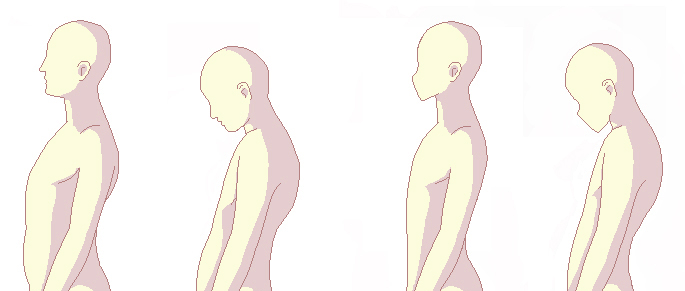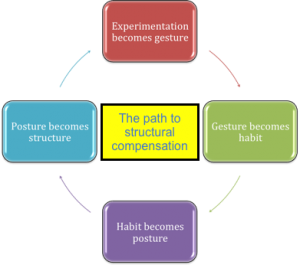Do you remember when you were a kid and you’d pull a face, and someone (usually your mother) would state that if you kept doing that then you’d stay that way? Well here’s the thing. It turns out that in a manner of speaking, SHE WAS RIGHT!
The book ‘Fascial Dysfunction, Manual Therapy Approaches (2014)’ has contributions from over 20 renowned people in the fascial world such as Schleip, Pilat and Thomas Myers (of Anatomy Trains fame). In Chapter Three, Myers describes what he terms ‘The path to structural compensation’. It looks like this:
What does all that mean? My summation of the diagram is as follows:
Experimentation becomes gesture: Every movement begins as an experiment, a new expression of neuromotor firing. Myers gives the example of a baby at about 6 months old that rolls onto its belly. “As the eyes track Mom, the reflexive rotation and extension of the neck initiates the spinal rotation and extension, and the rest of the rolling over movement. When the strength of the muscles and bones and the proportion of the head to torso allow it, the child does indeed roll over’.
Gesture becomes habit: “Repeated enough, the sequence of firing becomes fixed as a habit”. The more times you do something, the more times you are likely to do it. Think of pulling that face again as a child, and how sometimes you’d get into trouble for pulling it and not even know that you were pulling it, or how now, as an adult, people (usually your partner) will say ‘oh there’s THAT face again’!
Habit becomes posture: “Habits, once firmly established, require a posture to maintain them”. Once a physical habit forms, your body’s tissues will continue to reinforce it. Wolffe’s Law states: Tissues (e.g. bone, fascia) remodel to forces or demands placed upon them. So – with everything you do, the amount you open your mouth when you talk, the posture you adapt when walking, your emotional state, down to the way you breathe (chest or abdominal breathing) is reinforced and that reinforcement becomes your posture. Once these habits are ‘set’, they are maintained in the cerebellum and brainstem and become ‘much less amenable to voluntary control’.
Posture becomes structure: Once you have set your posture every movement you make will now take place around and compensate for that structure. So – if you have a more or less mobile or stable than it should be region in your body, you will move, but you will move with compensations as part of the pattern. And hence every time you move with that new structural adaptation, you are, in terms of your tissue, experimenting again.
How does this information affect you as a coach / trainer? Throughout the second chapter of the book, Leon Chaitow calls exercise a ‘theraputic option’ for certain types of connective tissue (fascial) dysfunction. However, there’s a word of warning to coaches / trainers. A sentence in chapter two also reads: “Inflammation can be excessive and therefore promote excessive collagen deposition, leading to fibrosis”. Inflammation, remember, can be caused by excessive, repetitive exercise. Fibrosis is not a good thing in terms of mobility.
The takeaway: ensure that you as a coach / trainer are doing everything you can to reduce inflammation and aid the hydration of tissues; that will help them slide and glide. “This will help your connective tissue framework perform its tasks: providing strength, elasticity and biotensegrity.” (Leon Chaitow)
Help your tissue return to its best possible state and your face won’t get stuck that way forever!
Reference: Chaitow. L. (2014). Fascial Dysfunction, Manual Therapy Approaches. Handspring Publishing Limited. United Kingdom. ISBN 978-1-909141-10-0

